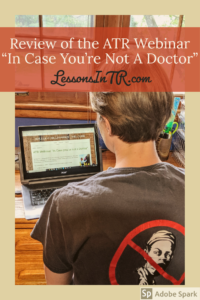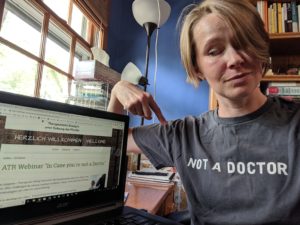Today I have the pleasure of writing a review of the Adaptive/Therapeutic Riding (ATR) Webinar “In Case You’re Not A Doctor” by Esther Schlegel, in which she teaches human anatomy and physiology related to horseback riding, and explains many conditions and disabilities with their related considerations for horseback riding. I am happy to say I’ve been able to listen through her 7 1/2+ hour webinar series and would like to recommend it! For more information, keep on reading.
Full disclosure: I am not getting paid for this review or paid by affiliate links to the webinar. In fact, I paid to watch the series, albeit at a discounted price in agreement to write a review, which was a collaborative idea.
(Also note the T-shirt above means “I am not a doctor,” not “no doctors,” haha!)
Review of the ATR Webinar “In Case You’re Not A Doctor”
About Esther
It’s always good to know why you should listen to and believe the presenter. This webinar series was created by Esther Schlegel, whose program Aufsteiger‘s website explains her background as: “Occupational Therapist Bsc. with Hippotherapy (AHA), Therapeutic Riding Senior Instructor (CanTRA), Instructor of Beginners in English Riding (Equine Canada). She learned, lived and worked in Germany, the Netherlands, USA and Canada before she started her own practice, which she runs with lot heart and competence. Besides treating clients in her practice she enjoys teaching Occupational Therapy students at a local college as well as offering clinics regarding various topics related to Occupational Therapy, Hippotherapy and Adaptive (Therapeutic) Riding.” So she is a valid source of information!
I would consider her webinars as counting toward PATH Intl. Continued Education hours because their CE Guidelines state that they accept “Online learning through online courses, webinars or videos from Higher Education Institutions, Professional Associations, or other reputable learning sources” and I would consider her a reputable learning source due to all those credentials. (Esther notes that so far all associations have accepted her clinics and webinars as updating/education hours).
Also, she recently wrote the post Multisensory Teaching Approaches for Adaptive Riding for this blog – check it out!
About The Webinar
Esther’s webinar series “In Case You’re Not A Doctor” was made to help instructors develop their riders’ full potential by expanding the instructor’s knowledge about human anatomy, disabilities, and related considerations. The series consists of 5 modules which can be purchased together or individually. Each module includes a video that alternates between Esther teaching and showing powerpoint notes, a PDF handbook of the information in the video, a 5 question test at the end of the handbook which you answer and turn in to receive a certificate of completion, and an optional follow up phone call.
The first module is “Human Anatomy and Physiology Related to Horseback Riding.” Esther starts with anatomy because you must first understand the body as it typically functions before you can understand the body which has a disability or condition – makes sense! Topics include the skeletal and muscular systems, how these interact in movement, the cardinal planes of movement, how all this relates to horseback riding, and the muscle groups specifically related to riding with stretches you can use for each. This video is the longest at 2 hours 48 minutes.
In the second through fifth modules, Esther explains the most common conditions and disabilities we see as adaptive riding instructors. For each condition she also gives considerations, contraindications, adaptations and tips regarding horseback riding. The modules are, with video time lengths after: Orthopedic Conditions (1:15 hr), Neurological and Neuromuscular Conditions (2:16 hr), Neurodevelopmental Conditions (:53 hr) and Genetic Conditions (:29 hr).
My Experience
First off, I like this series because I am…
(…very excited to have found a matching shirt in husband’s closet).
Overall, I loved this webinar series! Honestly, I was not sure what to expect because I’ve always had a hard time staying interested in scientific details, but I was pleasantly surprised at how much I enjoyed it due to Esther’s way of relating everything back to horseback riding so I could really see the application – and, I have to admit, her lovely accent! Here are some more things I liked about the series:
Detail – All of the modules are very detailed and pack a lot of information in – but, not being a doctor, it was not so overwhelming that I couldn’t follow. The first module is the longest due to all this detail, but it is was really helpful in preparing me for the following modules which discuss how certain conditions affect certain parts of the body. By the end it really struck me how riding a horse uses the whole body and every single muscle like no other sport does! I already knew this, but now it resonates with me even deeper.
Graphics – Esther provides excellent graphics throughout of the specific bones, muscles, nerves, brain, etc. which I really appreciated because it helps me visualize better what is being explained, and keeps my attention.
Stretches – At the end of the first module, when she details the muscle groups related to riding, she also includes stretches that would help people with tightness in those sections. I absolutely loved this because I’ve heard a lot about stretches you can do on the horse, but not so much about stretches your riders can do before mounting, so this is a great resource.
Conditions & Disabilities – The second through fifth modules were a great survey of the majority of conditions and disabilities you will see when teaching adaptive/therapeutic riding. I love this as an introduction to disabilities, something I feel I didn’t have in my instructor training – I just read PATH Intl.’s Precautions and Contraindications, which is valuable in its own right, but is not meant to be your first reading on disabilities. I was also excited to hear about conditions not specifically mentioned in the Precautions & Contraindications and wish I had been aware of earlier, such as Prader Willi Syndrome and Rhett Syndrome, and shunt and ostomy illustrations and locations.
Considerations & Adaptations – I loved that she included considerations and adaptations for each condition. If you are already certified you should know most of these, but there were some that were new ideas to me, and I felt it was a great refresher.
Repetition – At times the webinar gets repetitive, mostly when hearing similar adaptations for similar disabilities, but by the end I really appreciated this because that’s how you learn and remember things – and I really remembered those adaptations! It worked!
Unaffiliated – I liked that Esther does not claim to be affiliated with a specific certifying body for adaptive/therapeutic riding, but rather mentions checking with whatever association you are with for their specific contraindications, so this webinar could be viewed by anyone involved in adaptive/therapeutic
Manuals – I loved having notes already made up for me in the manuals! As a compulsive note taker, I felt I could focus on watching the video (or honesty, doing dishes while watching the video) instead of constantly writing notes or trying to redraw her images because I knew I had that manual. It’s also a good resource for those (like me) who need to review notes to remember things.
Tests – I like that she has little 5 question tests at the end of each module in the manual to send to her for a certificate, as it encouraged me to focus even more while watching the videos so I would better being able to take the test or at least know where to find the info in the manual.
Certificates – When you complete the little test, Esther sends you a certificate of completion of the webinar. If needed, you can use this for your continued education to prove to your association that you not only purchased the webinar but also viewed it!
Who This Webinar Is For
Everyone – I think this would be a great webinar series for anyone in the industry to watch, unless you ARE a doctor and know everything about anatomy and disabilities and adaptations by heart. It’s a great introduction or refresher. But in particular…
Instructors In Training – The whole “In Case You’re Not A Doctor” series would be great for people starting their instructor training because it is such a good introduction to disabilities and adaptive/therapeutic riding. It’s an excellent supplement to PATH Intl.’s Precautions & Contraindications and is more interesting than just reading the info.
Adaptive/Therapeutic Riding Instructors – I think the webinars are a great refresher for instructors of all experiences. I’m probably not the only person who needs to hear things so many times to “get it”, and Esther includes lots of little tips for adaptations and conditions which you may not have heard before or just not remember. Also, if you are currently not teaching, it’s a good review to keep things fresh in your head for when you do instruct again.
Other Thoughts
I really can’t think of any criticisms of this webinar series!
Do be aware that the time frame to watch them is 1 week, but I imagine if I had no kids that fitting it in would have been much easier. But for me that was difficult and Esther was kind enough to leave it open for me another week. Thank you, Esther!
Purchase Info
The 5 modules of the ATR Webinar “In Case You’re Not A Doctor” can be purchased from Esther’s website here. You can buy them individually or all together at a discount. Note that the price on the site is in EUROS. The day of writing this the whole package rate in dollars was $232, which for 7.5 hours comes out to $33/hour, which is actually comparable to PATH Intl.’s and CHA’s webinar member prices ($30-40), although the individual webinars differ greatly in price due to different time lengths. The website says that group rates can be discussed.
Conclusion
I hope you got a good feel for what the ATR Webinar “In Case You’re Not A Doctor” is all about and if it’s a good fit for you! Make sure to check out Esther’s Aufsteiger website to ask her any questions.
Enjoy!
****************
Note: This is not professional advice, this is a blog. I am not liable for what you do with or how you use this information. The activities explained in this blog may not be fit for every rider, riding instructor, or riding center depending on their current condition and resources. Use your best personal judgement! If you would like to contribute an activity or article, please contact me here, I would love to hear from you!

